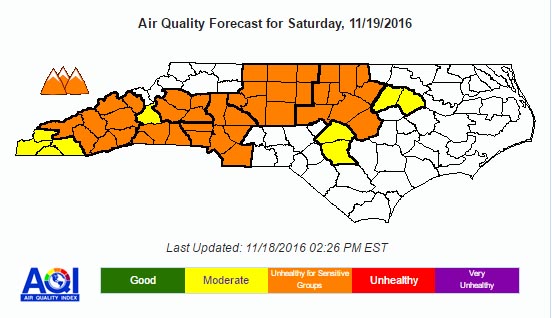 The air quality forecast for Saturday, November 19 is Code Orange, or “Unhealthy for Sensitive Groups.” Children, older adults, active people, and those with heart disease or respiratory conditions (like asthma) should limit prolonged or heavy exertion outdoors.
The air quality forecast for Saturday, November 19 is Code Orange, or “Unhealthy for Sensitive Groups.” Children, older adults, active people, and those with heart disease or respiratory conditions (like asthma) should limit prolonged or heavy exertion outdoors.
However, air conditions may vary throughout the day and across the county. Use your own observations to determine how the smoke is affecting air quality in your immediate area. If you can see haze and smell smoke, then air quality is not good and you should limit your outdoor activities.
 You can also use this guide from the N.C. Division of Air Quality to estimate air pollution based on visibility ranges. Visibility data are available from the National Weather Service at www.weather.gov/gsp.
You can also use this guide from the N.C. Division of Air Quality to estimate air pollution based on visibility ranges. Visibility data are available from the National Weather Service at www.weather.gov/gsp.
WHAT CAN I DO TO STAY SAFE?
Check local air quality reports. Visit www.ncair.org for daily updates on air quality.
Limit physical activity. Increased physical activity requires people to breathe faster, breath deeper, and take in more air—and therefore, more air pollution—into their lungs. You can reduce the amount of time you are breathing hard, take more frequent breaks, and reduce how hard you are working or exercising.
Stay inside and keep indoor air as clean as possible. Keep windows and doors closed. Run your HVAC if you have one, but keep the fresh-air intake closed and the filter clean to prevent outdoor smoke from getting inside.
Avoid activities that increase indoor pollution. Burning candles, fireplaces, or gas stoves can increase indoor pollution. Vacuuming stirs up particles already inside your home, contributing to indoor pollution. Smoking also puts even more pollution into the air.
Follow the advice of your doctor or other healthcare provider about medicines and your respiratory management plan if you have asthma or another lung disease. Consider evacuating the area if you are having trouble breathing. Call your healthcare provider for further advice if your symptoms worsen.
SHOULD I BE USING A FACE MASK?
Some recent reports have suggested the use of respirators and dust masks as protection from smoky air conditions.
For most people, filtering face masks will provide little if any protection, and may offer the wearer a false sense of protection.
For people with heart and respiratory diseases, respirator use can actually be dangerous and should not be worn without a doctor’s supervision. Filtering respirators and masks can make the work of breathing more difficult, leading to increased breathing rates and heart rates.
Dust masks (with one strap) are made to filter large particles, like sawdust, and will provide no protection against the fine particles found in wildfire smoke. Covering the nose and mouth with a wet or dry bandanna or a tissue also provides no protection against fine particles. Surgical masks are designed to prevent the spread of illness from the wearer to others, and will not protect against smoke particles, either.
N95 respirators (with two straps) may filter out some of the fine particles that may be found in smoke, but only if there is a proper fit to the wearer’s face. They will not protect against toxic gases and vapors. Most people will find it difficult to use the respirators and masks correctly. They must be sealed to the face on all sides to be effective, and it is impossible to get a good seal on individuals with facial hair. Even healthy adults may find that the increased effort for breathing makes it uncomfortable to wear a respirator for more than short periods of time.
An N95 respirator should be used as a last resort after taking all actions to the right or if outdoor activity cannot be avoided.

